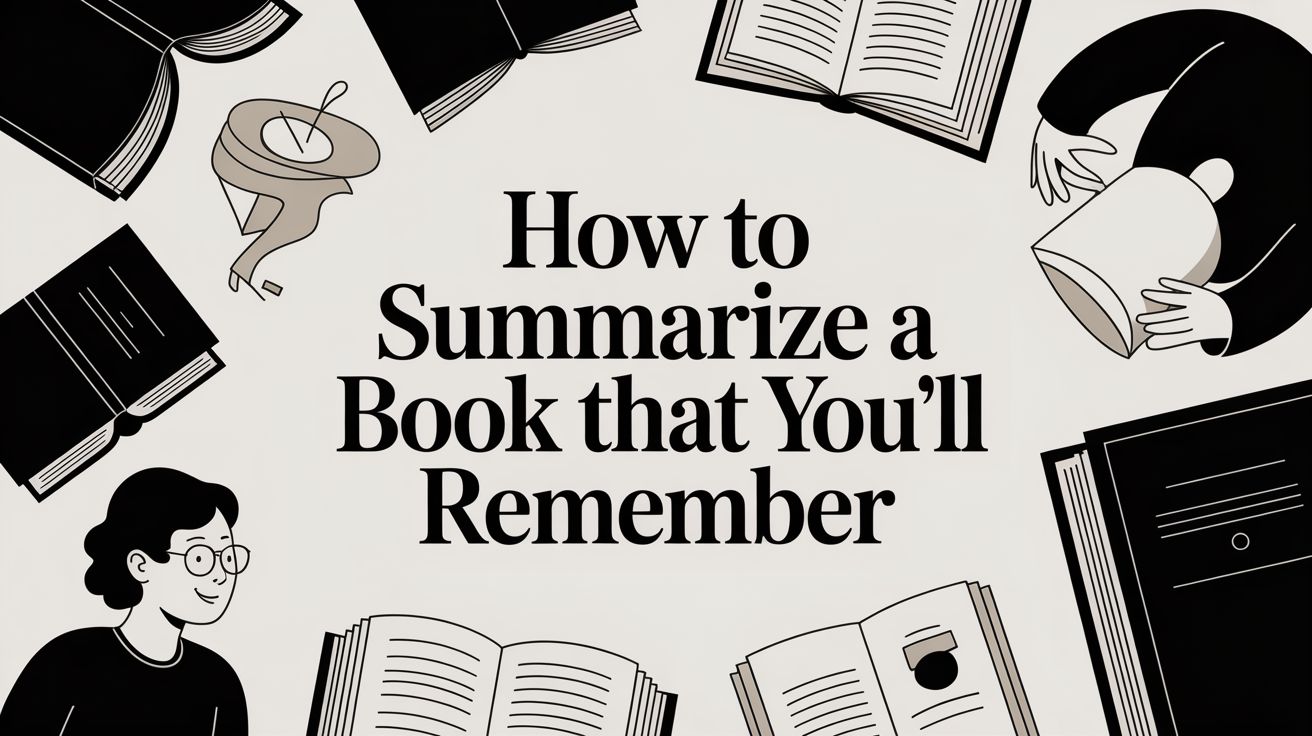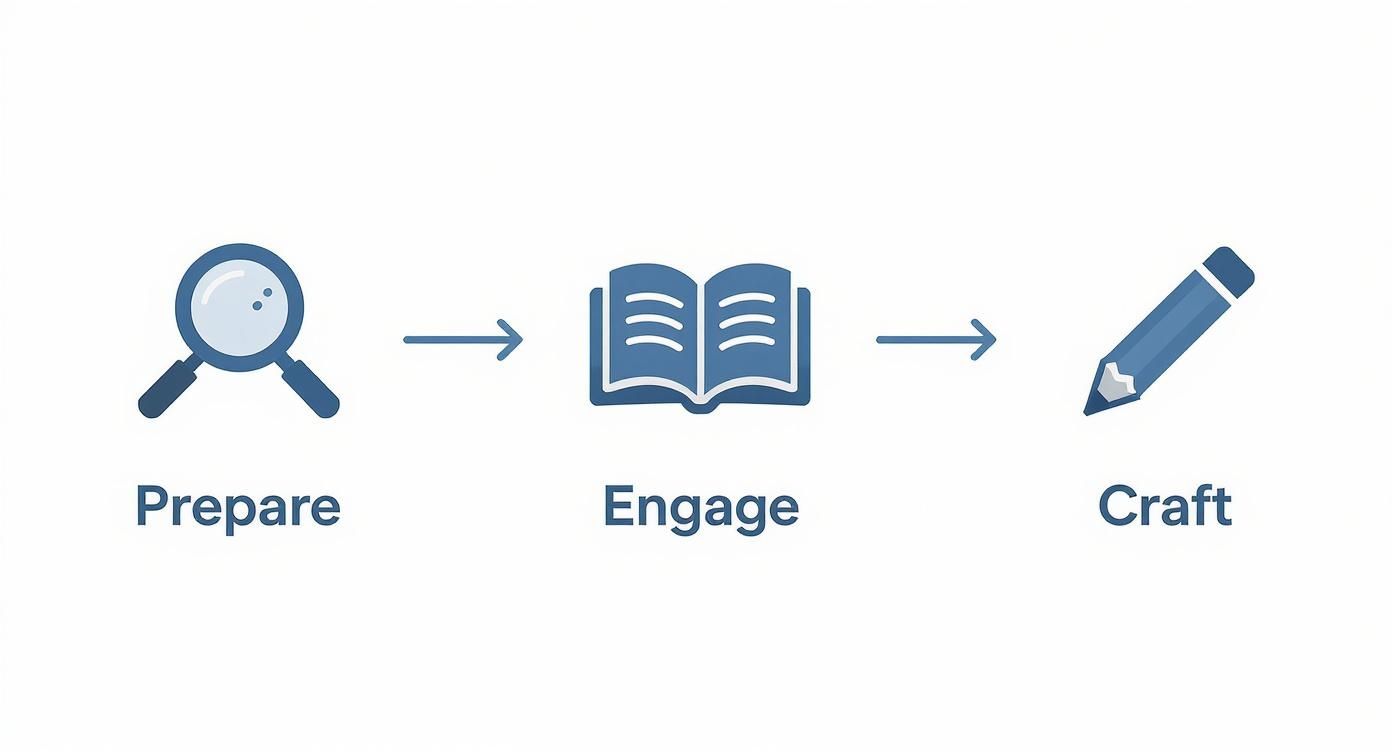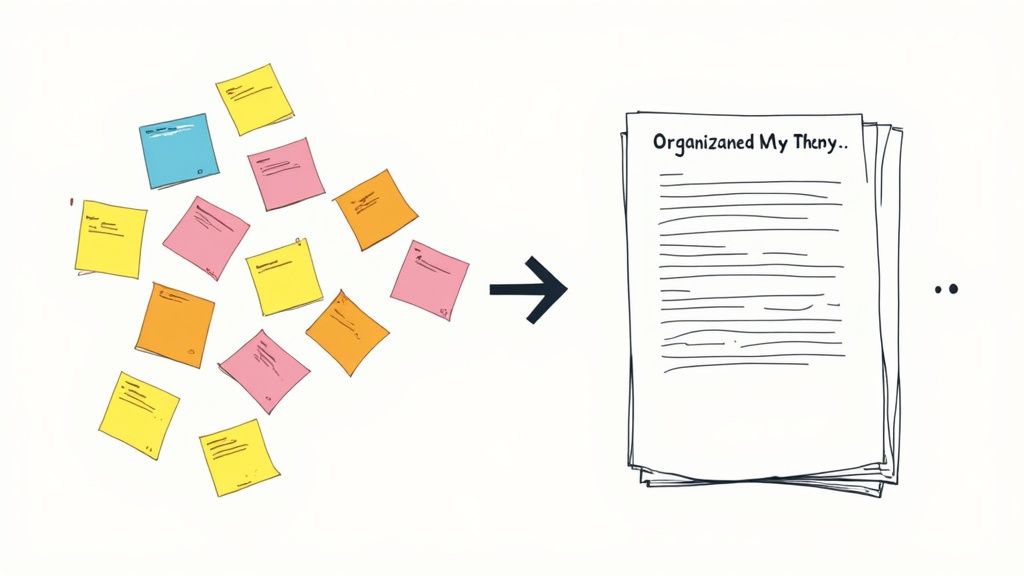How to Summarize a Book That You'll Remember
Learn how to summarize a book with our guide for students. Master practical note-taking and writing techniques to capture the core ideas of any text.

Knowing how to summarize a book is one of the most valuable skills you can pick up as a student. It’s far more than just chopping down 300 pages into one; it’s an exercise in capturing a book's very soul. A truly great summary moves beyond a simple list of events to distill the author's core arguments, underlying themes, and ultimate purpose.
Beyond Plot Points: Mastering the Book Summary
When you get this right, you’re proving you’ve engaged with the material on a much deeper level. A well-crafted summary shows you've grasped the author's main message, whether that’s a dense scientific theory in a textbook or the subtle emotional journey of a character in a novel. This skill pays dividends far beyond a single book report—it sharpens your critical thinking, forces clarity into your own writing, and dramatically improves how well you retain information for exams.
Think about it: the global book market is expected to hit $142.72 billion, a massive number driven in part by our modern hunger for quick, digestible information. We see this everywhere, from apps like Blinkist to the abstracts in academic journals. The ability to get to the core of an idea quickly is a currency in today's world. By learning how to summarize effectively, you’re not just finishing homework; you're building a skill that's perfectly in sync with how we consume information now.
The Three Phases of an Effective Summary
To really nail a summary and move from a basic retelling to a powerful analysis, you need a plan. Trying to do it all at once is a recipe for getting lost in the weeds. I’ve always found it helpful to break the process down into distinct phases. This approach keeps you focused and ensures you don't miss the big picture.
Each stage builds on the one before it, creating a solid framework for your final summary. Think of it as a simple workflow: Prepare, Engage, and Craft.

This visual really drives home the point that a good summary isn’t just something you write; it's the result of a thoughtful process that starts long before you type the first word.
Here's how these phases typically play out:
- Prepare: This is all about the groundwork. Before you even dive into chapter one, you're doing a bit of reconnaissance—looking into the author's background, skimming the table of contents, and forming a general idea of what the book is trying to achieve.
- Engage: Now you're in the thick of it. This is the active reading and note-taking part of the process. You’re hunting for the main thesis, tracking recurring themes, and pulling out the key evidence the author uses to make their case.
- Craft: This is where you bring it all together. You take your messy notes and transform them into a clean, coherent summary. It involves outlining a logical structure, writing with precision, and polishing your draft until it’s a true and concise reflection of the original work.
This table breaks down the process even further, showing how each stage contributes to the final product.
Core Stages of an Effective Book Summary
| Stage | Primary Goal | Key Actions |
|---|---|---|
| Prepare | Establish Context & Scope | Research the author, skim the introduction/conclusion, review the table of contents. |
| Engage | Identify & Extract Core Ideas | Read actively, highlight the thesis, take structured notes on themes, arguments, and evidence. |
| Craft | Synthesize & Refine | Outline the summary, write the first draft, revise for clarity, conciseness, and accuracy. |
By following this kind of structured workflow, you develop a reliable system that you can apply to any book, no matter if it’s a dense work of non-fiction or a sprawling novel.
For more deep dives into study skills and writing strategies, you can find helpful articles like our guide on how to write an essay fast over on the Feen AI blog.
Get Your Bearings Before You Even Crack the Cover
Believe it or not, a great summary starts long before you read the first chapter. You need to do a little reconnaissance first. This whole pre-reading phase is about building a mental framework, so when you actually start reading, all the information has somewhere to go.
Don't just blow past the book's cover and the blurb on the back. These aren't just for decoration; they're marketing tools designed to tell you exactly who the book is for and what it's all about. Look for keywords, check out any glowing reviews from experts, and just get a feel for the tone. Is this a dense academic text, a practical business guide, or maybe a piece of narrative journalism?
Next, flip inside to the author's bio and the introduction. The bio gives you some context on who this person is, what makes them credible, and any potential biases they might bring to the table. The introduction, though, is pure gold. It’s where most authors lay out their entire argument. They’ll often flat-out state their thesis or the central question they're trying to answer.
A truly effective summary isn't just a reaction to what you've read. It's the confirmation of a hypothesis you started forming before you even got to page one. All the clues are right there on the cover, in the intro, and in the table of contents.
Put on Your Detective Hat
Once you've sized up the packaging, it's time to examine the book's skeleton: the table of contents. This is your roadmap. Pay close attention to how the author has structured their argument or story.
- Chapter Titles: Are they straightforward statements, intriguing questions, or something more creative? This tells you a ton about the book's style.
- Section Breaks: See if chapters are bundled into larger parts. This high-level structure points to the main pillars of the author's argument.
- Logical Flow: Is the book laid out chronologically? Thematically? Does it present a problem and then a solution? Figuring this out early on will keep you from getting lost in the weeds later.
For instance, a non-fiction book like Jonathan Haidt’s The Anxious Generation has parts like "The Great Rewiring" and "Collective Actions for Change." That immediately signals a problem-solution structure. A novel is different; its chapter titles will likely hint at crucial plot points or a character's journey.
Skim Like You Mean It
The last piece of prep work is a strategic skim. This isn't about leisurely flipping through the pages; you’re on a mission, hunting for signposts. Go through the whole book, but only let your eyes land on these specific things:
- Headings and Subheadings: They're the outline of every key idea in each chapter.
- First and Last Sentences of Paragraphs: This is a classic writer's trick—the main idea is often at the beginning, and the conclusion is at the end.
- Bolded Text and Pull Quotes: The author is basically shouting, "Hey, this part is important!"
- Charts, Graphs, and Images: Visuals are often a shortcut to understanding a complex point that might take pages to explain in text.
Once you’ve done this, you should have a pretty solid theory about the book's core message. You've essentially created a mental outline, which turns you from a passive reader into an active investigator, ready to pull out the most important information with ease.
Read Actively and Take Smarter Notes
Let's be honest: passive reading is the fastest way to forget everything you just read. If you just let the words wash over you, your brain won't hang on to the important stuff. To write a solid summary, you have to switch from being a passive reader to an active investigator. Think of each chapter not as a block of text to get through, but as a puzzle you're trying to solve.
Your mission isn't to copy down every single detail—you're not a human photocopier. You're an analyst. For non-fiction, that means hunting for the author's core arguments. For a novel, you're tracking the critical plot developments and figuring out what makes the characters tick. Getting into this mindset is the secret to crafting a summary that actually shows you understood the book.
And this skill is more important than ever. The way we read is changing, with audiobooks becoming a huge part of the market—their revenues are projected to keep climbing. This shift means we need to be even better at grabbing and holding onto key information. You can dig into more trends on the evolving book market over at Mordor Intelligence.
Adopt an Annotation Strategy
Good annotation feels like you're having a conversation with the author. Whether you’re old-school with a highlighter and sticky notes or using the tools in your e-reader, the key is to have a consistent system. A simple color-coded approach works wonders.
- Yellow Highlighter: Use this for the big kahuna—the main thesis or the central argument of a chapter.
- Blue Highlighter: Reserve this for the proof. This is for the key statistics, compelling evidence, or powerful examples the author uses to make their case.
- Margin Notes: This is your space to talk back. Jot down questions, connections, or critiques. Think things like, "This ties back to Chapter 2's point on X," or "Hmm, is this really strong enough evidence?"
- Circling Keywords: Keep an eye out for recurring words or concepts and circle them. These are often signposts pointing to the book's major themes.
By forcing yourself to categorize information as you go, you’re already building the skeleton of your summary.
Use a Structured Note-Taking Framework
Once you start pulling out these key ideas, you need a place to put them that isn't just a chaotic mess on a blank page. A structured system like the Cornell Method can be a lifesaver, giving you a clear, organized way to capture and, more importantly, review everything.
The system is simple. It just divides your page into three sections: a large column for your main notes, a smaller column on the side for cues, and a summary box at the bottom.

As you can see, the layout is designed for recall. While you read, you fill the main column. After, you use the side column to turn those notes into testable questions or keywords. Finally, you write a quick summary at the bottom. This last step is what really cements the information in your brain.
Weaving Your Notes Into a Coherent Story
You've done the hard work of pulling out the key ideas from the book. Now, with a solid set of organized notes in hand, you're ready to start building. This next step is all about shaping those scattered points, quotes, and observations into a smooth, logical narrative. You’re not just listing facts; you're creating a new, condensed version of the book's core message.
The first thing you need is a powerful topic sentence. Seriously, this one sentence is your North Star. It has to capture the book’s entire thesis or central theme in a single, clear statement. Think of it as the ultimate elevator pitch for the book—everything else in your summary will flow from and support this main idea.

Let’s take Jonathan Haidt’s The Anxious Generation as an example. A solid topic sentence might look like this: "Haidt argues that the widespread youth mental health crisis is a direct result of the modern shift from a play-based to a phone-based childhood, fueled by both overprotective parenting and unrestricted social media access." Boom. Right away, the reader knows the problem, the cause, and the scope of the book's argument.
Structuring Summaries for Different Needs
Let's be real—not all summaries are the same. The length and level of detail you need will totally depend on why you're writing it. Is this for a quick book club discussion, or is it a detailed analysis for a final paper?
Here’s a practical breakdown for structuring your summary based on your goal:
- The One-Paragraph Punch: Start with your killer topic sentence. Then, add three or four key sentences that each hit on a major argument or plot point. Wrap it up with a concluding sentence that drives home the book's main takeaway.
- The One-Page Deep Dive: This gives you a bit more room to breathe. Kick things off with your topic sentence as the intro. Then, give each major theme or part of the book its own dedicated paragraph. A short concluding paragraph at the end can tie all the threads together nicely.
- The Extended Analysis: This is where you can really get into the weeds. After your introduction, create sections with clear headings that often mirror the book’s own structure. This is your chance to bring in those specific examples, direct quotes, and supporting evidence you gathered during your note-taking.
No matter the length, the fundamental principle is the same. You're building a logical structure that accurately reflects what the author was trying to say.
A quick but crucial reminder: The goal is to paraphrase, not plagiarize. You're restating the author's ideas in your own words to show you get it. Always stay true to the original meaning and intent.
Tying It All Together
With your outline ready, it's time to actually write. This is where you connect your clusters of ideas using transitional words and phrases to make the whole thing read like a seamless, polished piece. Think of these transitions as signposts that guide your reader through your logic.
Take a second to consider the relationship between your points.
- Need to add a related idea? Use words like additionally, furthermore, or in the same vein.
- Trying to show cause and effect? Go for consequently, as a result, or therefore.
- Introducing a contrasting point? Phrases like however, on the other hand, or conversely are your best friends.
Using these little connectors is what keeps your summary from sounding like a choppy, disconnected list of facts. It’s what transforms your raw notes into something truly readable and persuasive. Honestly, getting this flow down is a skill that’ll help you far beyond book summaries—it’s a cornerstone of strong academic writing. If you want to sharpen this skill further, our guide on how to write an essay fast has even more strategies to help.
Using AI as Your Study Buddy—The Smart Way

Let's be real: AI can be a game-changer when you're staring down a dense book that needs summarizing. But it's essential to get the relationship right. Think of an AI tool as a super-fast research assistant, not the one writing your paper. The whole point is to use it ethically to handle specific tasks that speed you up, not to outsource your own thinking.
Your goal should be to use technology to support your process, making sure the final summary is a product of your brain. For instance, feeding a confusing chapter into an AI to spit out a few bullet points can save you a ton of time. This gives you a quick-and-dirty outline to compare with your own notes, often highlighting a key idea you might have breezed past.
How to Actually Use AI for Summaries
Instead of a lazy prompt like "summarize this book"—which will get you a generic, soulless report—you need to be more precise. Treat AI like a scalpel, not a sledgehammer. The trick is to break the big job of summarization into smaller pieces where the tech can actually help.
Here are a few ways I've seen students use AI effectively:
- Extract Key Points: Drop a chapter in and ask for the top five arguments. Now you have a checklist to see if your own reading picked up on the same things.
- Untangle Sentences: Struggling with a ridiculously long academic sentence? Ask the AI to rephrase it in a few different, simpler ways.
- Find Connections: Prompt the AI to find thematic links between, say, a character's decision in Chapter 3 and a reveal in Chapter 8. This can kickstart some great analytical ideas.
This approach keeps you in the driver's seat. You’re still the one doing the critical thinking; the AI is just handling some of the grunt work so you can focus on the big picture.
The golden rule of academic integrity hasn't changed. Your final work has to show your understanding. AI is a tool to help you get there faster, not a machine to create understanding for you.
Keeping Your Own Voice Front and Center
The biggest danger of leaning too heavily on AI is that your summary will sound like... well, a robot wrote it. An AI-generated summary is all facts and no flavor. It can't offer the personal insights or the subtle connections that show you've truly wrestled with the material.
To make sure that doesn't happen, always treat AI output as raw material. It's a starting point that you need to fact-check, rewrite, and inject your own perspective into. For students who want a helpful sidekick, tools like Feen AI are built to explain concepts and help you structure your thoughts without writing the thing for you. At the end of the day, your personal take is what makes your summary worth reading.
Time to Polish: From Good Draft to Great Summary
https://www.youtube.com/embed/NrwQeZqFJqg
Getting that first draft down is a huge win, but don’t stop there. The real magic happens in the editing process, where you refine your summary, making it sharp, clear, and academically sound. This is your chance to turn a solid effort into something truly impressive.
A simple but incredibly effective trick is to read your summary out loud. You'll be amazed at how quickly you spot clunky phrasing or sentences that just don't flow right. As you're reading, ask yourself: does my summary reflect the original book's tone? A serious academic text, for example, shouldn't be summarized with overly casual language.
Once you’ve smoothed out the language, it’s time to be ruthless with your word count. Go on a hunt for any word that isn't pulling its weight. Phrases like "The author makes the point that..." can almost always be tightened to a punchier "The author argues..." In a summary, every single word counts.
A Quick Revision Checklist
Revising is more than just a spell-check. It’s about making sure your summary does its job effectively. A little structure goes a long way here.
Run through this checklist before you call it done:
- Accuracy: Does your summary stick to the book's core arguments? Have you accidentally inserted your own opinions or misinterpreted a key idea?
- Flow: Do the paragraphs transition smoothly from one to the next? Use transition words and phrases to guide your reader through the logic.
- Brevity: Is it lean? Cut out jargon, repeated points, and filler words. Make every sentence count.
- Tone: Does the feel of your summary match the feel of the source material?
The goal of revision is to remove everything that isn't the book. Your voice should be a clean window through which the author's ideas are clearly seen, not a filter that colors them.
Don't Forget to Cite Your Source
This is the final, non-negotiable step. Proper citation is how you give credit where it's due, steer clear of plagiarism, and lend credibility to your own work by showing your sources.
Your instructor will likely specify a format, but for most students, it'll be MLA or APA. Getting it right is pretty straightforward.
MLA Example:
Haidt, Jonathan. The Anxious Generation: How the Great Rewiring of Childhood Is Causing an Epidemic of Mental Illness. Penguin Press, 2024.
APA Example:
Haidt, J. (2024). The Anxious Generation: How the great rewiring of childhood is causing an epidemic of mental illness. Penguin Press.
Taking these final steps ensures all your hard work is presented professionally and responsibly.
When you need to pull key points from a dense chapter or clarify complex ideas, Feen AI can be an indispensable study partner. It helps you turn long readings into concise summaries and offers the homework help you need to keep up. Try Feen AI today.
Relevant articles
how to write essay fast: Master quick research, outlining, and drafting to beat deadlines with a strong grade
